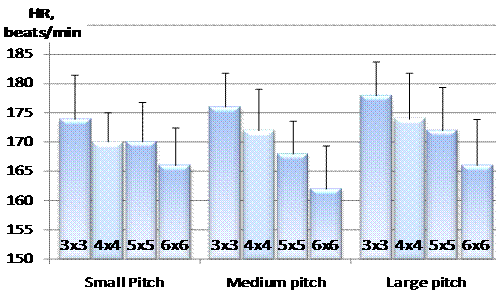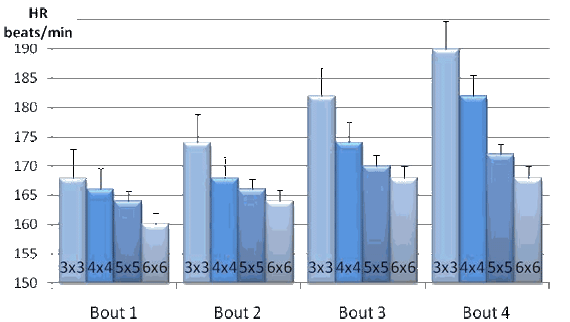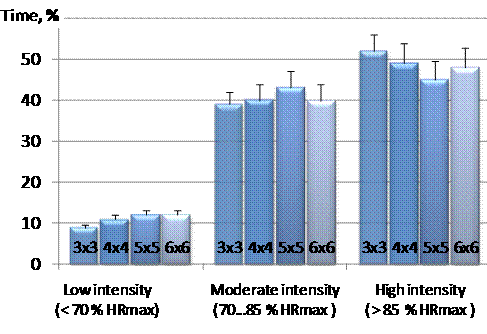FACTORS INFLUENCING CARDIOVASCULAR RESPONSES DURING SMALL-SIDED SOCCER GAMES PERFORMED WITH RECREATIONAL PURPOSES
Bondarev D.V.
Sevastopol National Technical University
Annotation. The aim of this study was to examine the influence of players’ number and pitch size on the heart rate responses during small-sided games of university students who engage in recreational activity. Main effect was found for players’ number and pitch size. Mean HR was significantly higher in 3x3 game than in 4x4, 5x5, 6x6 (p < 0,05). The influence of pitch size factor was significant when number of players were less to four (з2=0,323, p < 0,017). The results demonstrate that the number of players is a more influential factor than pitch size itself. In this regard, the dose-responses criteria should be considered for prescribing small-sided games as a mean for enhancing cardiovascular fitness.
Key words: soccer, exercise, intensity, heart rate.
Аннотация. Бондарев Д.В. Факторы, влияющие на реакцию сердечнососудистой системы при играх в футбол рекреационной направленности на уменьшенных полях. Целью исследования было определить, как влияет количество игроков и размер поля на ЧСС студентов при игре в футбол. Средняя ЧСС была выше в игре 3х3 по сравнению с играми 4х4, 5х5, 6х6 (p < 0,05). Влияние фактора "размер поля" было значимым при количестве игроков меньше 4 (з2=0,323, p < 0,017). Результаты показывают, что фактор "число игроков" значительней влияет на ЧСС, чем фактор "размер поля". Поэтому применяя игры в футбол на уменьшенном поле для повышения физической подготовленности необходимо учитывать дозировку нагрузки с учетом влияния вышеперечисленных факторов.
Ключевые слова: футбол, упражнения, интенсивность, ЧСС.
Анотацiя. Бондарев Д.В. Фактори, що впливають на реакцiю серцево-судинноi системи пiд час iгор в футбол рекреацiйноi спрямованостi на зменшених полях. Метою дослiдження було визначення як впливае кiлькiсть гравцiв i розмiр поля на ЧСС студентiв пiд час гри у футбол. Середня ЧСС була вище у грi 3х3 у порiвняннi з грою 4х4, 5х5, 6х6 (p < 0,05). Вплив фактора "розмiр полю" був суттевiй якщо кiлькiсть гравцiв дорiвнювала 4 (з2=0,323, p < 0,017). Результати свiдчать, що фактор "кiлькiсть гравцiв" значнiше впливае на ЧСС, нiж фактор "розмiр поля". Тому пiд час застосування iгор у футбол на зменшеному полi для пiдвищення фiзичноi пiдготовленостi необхiдно враховувати дозування навантаження з урахуванням впливу зазначених вище факторiв.
Ключовi слова: футбол, вправи, iнтенсивнiсть, ЧСС.
Introduction.
Soccer as a recreational activity is widespread among a diverse group of populations. Soccer related activities are used in physical education curricula amongst all ages, as a training practice in a wide range of sports in order to develop fitness conditioning, as well as tactical and technical abilities for participants.
So-called recreational soccer is usually carried out as small-sided games. Small-sided games (SSG) are any games played with less than eleven member teams and on a smaller sized field. SSG seem to be a popular alternative to the repetitious exercise modes traditionally employed for the improvement of cardiovascular fitness [3]. For instance, [2, 8] states that using SSG participation as a regular physical activity improves conditioning among students and older adults, and is maintained more successfully.
Such popularity of small-sided games can be explained by the facts that they lead to improved physical response, increased individual involvement, heightened levels of enjoyment and perceived competence. For example, during the last decade there have been several studies that have shown that small-sided soccer games can be characterized as having a high aerobic component with mean heart rates of 90 - 95% of maximum heart rate, which is similar to values observed for elite football players during competition matches [4, 11].
In [5] noted that the presence of the ball during small-sided games allows participants to improve physical fitness as well as technical and tactical skills.
Several factors influence the intensity of small-sided games such as the number of players, pitch size, coach encouragement, rules of the game and inclusion of goalkeepers. For example, in papers [9, 10] it was established that the smaller number of players, the higher exercise intensity and the more ball contacts amongst all soccer players.
Dellal et al. [4] and Rampinini et al. [11] showed that small-sided games are equally effective as interval running in enhancing aerobic fitness in soccer players. Unlike interval running during which intensity can be accurately manipulated through running speed and duration, the intensity of small-sided game is difficult to control. This is also important in recreational soccer. During small-sided games, it is difficult to accurately control the activity of players, and it is not very clear to what extent this training modality is in line with the aims of recreational activity.
In this context, it was reported [5] that HR monitoring during various small-sided games was considered valid to reflect the intensity of the soccer players’ activity.
Therefore, the aim of this study was to investigate how the number of players and pitch size affect the responses of cardiovascular system during small-sided games of university students who engage in recreational activity.
Methods.
Participants. Twenty five habitually physically active university students who engaged in recreational activity which does not associate with professional soccer were recruited to participate in this study (mean ± S.D.: age 18±1 years, height 1.76±6, weight 73.4±6.1 kg, HR max 202±2 beats min-1 , sum of four skin-fold thickness 22.4±3.1 mm, estimated VO2peak using the multistage shuttle test 48.0±4.2 ml kg -1 min -1). Before the study each participant gave written consent to participate in accordance with the local university’s ethical procedure.
Procedure. Data were collected twice a week from September to November during 24 training sessions. Each subject’s individual HRmax was initially determined by the completion of a Yo-Yo Intermittent Recovery Test. Players performed small-sided game in a 3x3, 4x4, 5x5, 6x6 a-side formats with goalkeeper, using small goals, free touches. Several balls were placed close in order to be able to instantly continue the game if a ball was out of the play. The small-sided games were performed on a three sizing played areas: small pitch, medium pitch and large pitch and completed outdoor on a artificial grass surface. However, when small-sided games performed as interval trainings consisting of four bouts of four min duration with 2 min of active recovery between bouts they carried out on medium-sized pitch. Each training session followed after 10...15 min warm-up (low-intensity running and dynamic stretching).
Heart rate was recorded using short-range radio telemetry (Polar Team System, Polar Electro OY, Kempele, Finland) at 5s intervals during each training session. After each session all heart rate data was downloaded to a computer and analysed using MS Excel. For each participant and for each game mean heart rate was calculated and used for the analysis.
The following heart rate zones were selected for the records: high intensity ( > 85 % HRmax), moderate intensity (70 - 85 % HRmax) and low intensity (< 70 % HRmax).
Statistical Analysis. Data are expressed as means±S.D. Differences in the heart rate between each pitch size and each small-sided games format were examined using a one-way analysis of variance (ANOVA) with repeated measures (within subject). A similar analysis was also used to compare the HR differences observed in bouts performing and time spending in intensity zones.
Effect size (h2) were also calculated and values of 0.01, 0.06, and > 0.15 were considered small, medium, and large respectively (Cohen, 1988).
When the results of ANOVA were significant, a post hoc analysis using the Bonferroni procedure was applied to make pair-wise comparisons. The level of statistical significance was set at P < 0.05. All statistical analyses were carried out using SPSS Statistical Analysis Software (SPSS® Version 12.0.01 for Windows®, Chicago, Illinois, USA)
Results.
The mean heart rate in the 3x3 small sided game was 178 ± 8 beats min-1, in the 4x4 172 ±7 beats min-1, in the 5x5 168 ± 6 beats min-1, and in the 6x6 164 ± 6 beats min-1. These values match to an exercise intensity of 88 ± 2% HRmax, 85 ±3 % HRmax, 83±4% HRmax , 82±4% HRmax. See figure 1.
No interaction between factors were observed (p >0.15). The factor "number of players" has a significant influence on HR (h 2=0,323, p < 0,017).
Post-hoc analysis reveals that mean HR was significantly higher in 3x3 game than in 4x4, 5x5, 6x6 (p < 0,05). However, between 5x5 and 6x6 the mean HR differences was insignificant (p > 0,05). Pitch size also affected HR as a main effect (h 2=0,323, p < 0,017).

Figure 1. Heart rate response during various SSG on various pitches
But this is true if number of participants less or equal to four. The influence of factor "pitch size" in a 5x5 and 6x6 games format on mean HR is negligible and insignificant.
The means HR observed on a medium-sized pitch for each format of small-sided games and for four bouts are presented in Fig.2.

Figure 2. Heart rate response during performing SSG in a bouts
The main effect for "Bouts" was significant (ŋ2=0,33, p < 0,05). Significantly lower mean heart rates were associated with the first bout than those elicit with bouts 2, 3, 4.
The main effect for "Number of players" was also significant (ŋ2=0,30, p<0,05). However, in the first bout there were no significant differences in HR between each small-sided game, while next bouts reveal that differences in HR increase.
Time spent by the players exercising at intensities more than 85 % HRmax was significantly higher (p<0.05) for all format of small-sided games than time spent at moderate intensity (70 - 85 % HRmax) and low intensity (< 70 % HRmax ) (figure 3).

Figure 3. Time spent exercising in different heart rate intensities
Discussion.
The aim of this investigation was to examine the influence of players’ number and pitch size on HR during recreational small-sided soccer games, also performing in bouts.
The results of the present study show that soccer small-sided games could be suitable methods for enhancing cardiovascular fitness in participants who engage in recreational activity. The intensity of small-sided games performed by university students varies from 82 to 88 % HRmax. Moreover, students played with intercity less than 70 % HRmax approximately 10 % of total game time. The ACSM have reported that minimum intensity level suggested for cardiovascular fitness is 55-65 % HRmax [1]
Our results show that players’ number involved in a game have a significant influence on training intensity. This result are in line with reports of [3, 5, 9] carried out with professional soccer players or youth players who are training to be professional. The 3x3 game displayed higher exercise intensity compared with the 4x4, 5x5 and 6x6 game. The possible explanation of this is that the less number of players, the more ball contacts for all players [6, 10], and when players touched and dribbled the ball more often during the game they expend more energy [12]. However, our study does not touch movement actions with a ball mostly due to the recreational purposes of soccer where technical and tactical skills are not the main aim of training.
In addition to confirm existing reports we demonstrate that in recreational soccer factor "players’ number" has an influence when the number of players is equal to or less than four players. The intensity of 5x5 and 6x6 game format displayed equal values. This is important for recreational soccer, as it helps to quantify the work load in order not to create more powerful stimulus that could lead to overtraining.
The influence of pitch size on intensity of small-sided games has been reported in papers Kelly et al., Owen et al, Rampinini et al [7, 10, 11]. For example, E. Rampinini [11] reported that exercise intensity of a 3x3 game on a small pitch was similar to that of a 4x4 game on a larger pitch. Our findings are in line with previous reports. However, present study shows that pitch size are not the main factor that influences HR.
Similar results were reported by [7] comparing pitch size in isolation which suggested that the pitch size factor influences HR in combination with other factors. Our results confirm this suggestion and show that factor "pitch size" has a significant effect only with factor "players’ number". When players’ number is more than four the factor "pitch size" does not affect HR substantially. One of the possible explanations can be that in previous studies elite soccer players were examined, where pitch size influences the quality of technical action with the ball (tackles, shots). However, in recreational soccer this influence may be not the same. This suggests that pitch size should be considered when special skill development is required because in recreational soccer the pitch size is not varied usually.
Heart rate responses showed variability across four bouts performed and number of players involved. The HR gradually increases from the first bout to the fourth bout. The initial phase of performing the game associated with no differences between game formats while the following bouts displayed greater differences.
In a 3x3 game at the 4-th bout the mean HR reached 190 ± 4 beats min-1. This could indicate that additional bouts would not be reasonable for students in recreational purposes. At the same time in a 5x5 and 6x6 games HR response at the 4-th bout reached a plateau on a level suitable for an aerobic training. Therefore, the results of the present study have an important practical implication. They suggest that performing small-sided games in bouts is suitable to achieve required exercise intensity.
Conclusions.
The conclusion of this study is that small-sided soccer games are suitable means of enhancing cardiovascular fitness for the general population. The intensity of these games has been shown higher than minimum intensity level recommended by ACSM for cardiovascular fitness improvements.
For recreational soccer small-sided games the pitch size is not the main factor which affects the training load. The number of players is a more influential factor. Performing small-sided games in bouts is suitable to achieve required exercise intensity in recreational population. In this regard, the dose-responses criteria should be considered for prescribing small-sided games as a mean for enhancing cardiovascular fitness.
Studies that compare players’ perception of effort during small-sided games with actual training load would be of great interest in order to monitor the actual level of training stimulus in a diversified exercise as soccer small-sided games.
Bibliographic references:
1. American College of Sports Medicine Position Stand. The recommended quantity and quality of exercise for developing and maintaining cardiorespiratory and muscular fitness, and flexibility in healthy adults // Med. Sci. Sports Exerc. - 1998. - № 30 (6). - Р. 975-991.
2. Bondarev D. Heart rate responses during recreational small-sided soccer games: effect of players’ number and pitch size / D. Bondarev // Scientific Report Series Physical Education and Sport. - University of Pitesti, 2010. - № 14. - P.56 - 59.
3. Cardiovascular responses during recreational 5-a-side indoor-soccer / F. Impellizzeri, C. Castagna, R. Belardinelli, and other // Journal of Science and Medicine in Sport. - 2006. - Vol. 10, № 2. - Р. 89 - 95.
4. Heart rate responses during small-sided games and short intemittent running training in elite soccer players: a comparative study / Dellal A, Chamari K, Pintus A, et al. // J Strength Cond Res. - 2008. - № 22(5). - Р. 1449 - 1457.
5. Hoff J. Soccer specific aerobic endurance training / Hoff J, Wislшff U, Engen LC // British Journal of Sports Medicine. - 2002. - 36(3). - Р. 218-221.
6. Jones S. Physiological and technical demands of 4 vs. 4 and 8 vs.8 in elite youth soccer players / Jones S., Drust B. // Kinesiology. - 39(2). - Р. 150-160.
7. Kelly D.M. The effect of pitch dimensions on heart rate responses and technical demands of small-sided soccer games in elite players / D. M. Kelly, B. Drust // Journal Science in Medicine of Sport. - 2008. - № 4. - Р. 145-152.
8. Recreational football as a health promoting activity: a topical review / Krustrup, P., Aagaard, P., Nybo L. // Scandinavian Journal of Medicine & Science in Sports. - 2010. - № 2. - Р. 1 - 13.
9. Mallo J. Physical load imposed on soccer players during small-sided training games / J. Mallo, E. Navarro // Journal of Sports Medicine in Physical Fitness. - 2008. - Vol.48, № 2. - Р. 166 - 171.
10. Owen A. Small-sided games: the physiological and technical effect of altering pitch size and player numbers / A. Owen, C. Twist, P. Ford // Insight: F A Coaches Assoc J. - 2004. - Vol.7, № 2. - Р. 50 - 53.
11. Factors influencing physiological responses to small-sided soccer games / E. Rampinini, F.M. Impellizzeri, C. Castagna [and other] // Journal of Sports Science. - 2007. - Vol.25, № 6. - Р. 659 - 666.
12. Reilly T. Small-sided games as an alternative to interval training for soccer players / T. Reilly, C.White // Journal of Sports Sciences. - June, 2004. - Vol.2, № 4. - Р. 33 - 38.
Came to edition 02.02.2011.
Бондарев Дмитрий Владимирович
p_e_department@ukr.net